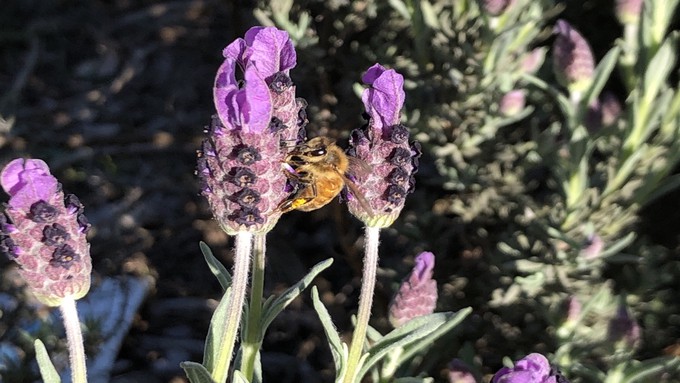
Tips to help make 2023 your best gardening year

Resolve to bring more pollinators into your garden with plants such as lavender. Kathy Morrison
Happy new year! Now what?
These past 12 months have been challenging for our gardens – something we can say about all drought years. How can we make 2023 better? Be prepared. Plan ahead. Have more fun.
We can’t control the weather (if we could, we would). But as we get drenched by an atmospheric river to close out 2022, our prospects for a “normal” water year at least look promising.
We thought the same thing last December when heavy rain brought declarations that our drought days were over. Then, we experienced the driest spring in Sacramento history.
Tradition dictates that it’s time to look ahead with resolve. But to do what? For us gardeners, these simple resolutions will make our lives easier and help our gardens thrive – no matter the weather.
1. Take notes. Be observant and write down what you see. Your landscape is changing. (Trees and shrubs grow; sunny spaces turn to shade.) You may need to make adjustments. Also, note what varieties did well, which didn’t. (This is key to veggie success.)
2. Use a calendar. Paper or digital, calendars are handy for jotting down those notes and keeping track of dates. For example, when did you plant seeds or transplants? When did you harvest your first tomato? You can refer to those dates later when making decisions about next season. (Tip: Get a master gardener calendar; it comes packed with monthly reminders.)
3. Do things at the right time. Plant, prune, fertilize, harvest; gardening is all about timing. For example, plants need important nutrients at critical steps in their development. Figure out in advance when you should feed certain plants (and mark it on that calendar!)
4. Install a smart controller and upgrade irrigation. Never have your sprinklers come on again during a storm. If you haven’t done this yet, now is the time. Water providers have rebates available for upgrading your irrigation technology. It will make your life simpler (and save water and money, too). For rebates: www.bewatersmart.info.
5. Invite wildlife into your garden and enjoy the show. Plant nectar- and pollen-filled flowers that hummingbirds, bees and butterflies love. Other birds like berries and seeds; they appreciate bushes that provide them a feast. Make them feel at home, too. Besides plants, provide a bird feeder, bird bath or bee house. For yourself, put a comfortable chair or bench in a spot where you can watch the antics of visiting winged friends. It’s a sure way to get more fun out of your garden space.
Comments
0 comments have been posted.Sacramento Digs Gardening to your inbox.
Food in My Back Yard Series
May 6: Maintain soil moisture with mulch for garden success
April 29: What's (already) wrong with my tomato plants?
April 22: Should you stock up on fertilizer? (Yes!)
April 15: Grow culinary herbs in containers
April 8: When to plant summer vegetables
April 1: Don't be fooled by these garden myths
March 25: Fertilizer tips: How to 'feed' your vegetables for healthy growth
March 18: Time to give vegetable seedlings some more space
March 11: Ways to win the fight against weeds
March 4: Potatoes from the garden
Feb. 25: Plant a fruit tree now -- for later
Feb. 18: How to squeeze more food into less space
Feb. 11: When to plant? Consider staggering your transplants
Feb. 4: Starting in seed starting
Sites We Like
Garden Checklist for week of May 11
Make the most of the lower temperatures early in the week. We’ll be back in the 80s by Thursday.
* Plant, plant, plant! It’s prime planting season in the Sacramento area. Time to set out those tomato transplants along with peppers and eggplants. Pinch off any flowers on new transplants to make them concentrate on establishing roots instead of setting premature fruit.
* Direct-seed melons, cucumbers, summer squash, corn, radishes, pumpkins and annual herbs such as basil.
* Harvest cabbage, lettuce, peas and green onions.
* In the flower garden, direct-seed sunflowers, cosmos, salvia, zinnias, marigolds, celosia and asters. (You also can transplant seedlings for many of the same flowers.)
* Plant dahlia tubers.
* Transplant petunias, marigolds and perennial flowers such as astilbe, columbine, coneflowers, coreopsis, dahlias, rudbeckia and verbena.
* Keep an eye out for slugs, snails, earwigs and aphids that want to dine on tender new growth.
* Feed summer bloomers with a balanced fertilizer.
* For continued bloom, cut off spent flowers on roses as well as other flowering plants.
* Add mulch to the garden to maintain moisture. Mulch also cuts down on weeds. But don’t let it mound around the stems or trunks of trees or shrubs. Leave about a 6-inch-to-1-foot circle to avoid crown rot or other problems.
* Remember to weed! Pull those nasties before they set seed.
* Water early in the day and keep seedlings evenly moist.